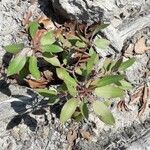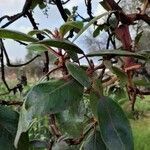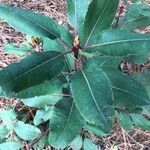Shrubs or trees, 2-4(-8) m; bark brick red, peeling in smooth flakes over most larger limbs, retained on base of trunk on older specimens and eventually over most of oldest parts of plant, becoming gray, irregularly roughened (twigs of newly emerging shoots usually densely villous, often with mixture of glandular hairs, fully developed twigs hairy and/or glandular-hairy, or glabrate or glabrous, twig bark soon loosening and exfoliating, older twigs usually smooth, brick red or glaucous-grayish red). Leaves ± equal in size throughout; petiole 1.2-2.5 cm, base slightly decurrent, glabrate; blade green or slightly lighter green abaxially, pale or bright olive-green or glaucous-green, elliptic or slightly ovate-elliptic, (2.5-) 4-6(-7.5) × (1.2-)1.8-3(-4) cm, base usually tapered, rarely slightly cordate, (margins smooth or irregularly toothed on sprouts), apex acute or obtuse, surfaces glabrous or ± hairy. Inflorescences (often showy), varying from densely clustered or openly-branched to relatively few-flowered; axes hairy, with both glandular and eglandular hairs intermixed. Pedicels accrescent, obliquely erect to pendulous, 1.6-3.2 mm, hairy, with both glandular and eglandular hairs intermixed; bract (accrescent), clasping base, reddish or tan, scalelike, 1.3-2 mm (to 2.9-3 mm in fruit). Flowers: calyx tan (sometimes with blush of pink), (1.8-3 mm), lobes 1-1.2 mm, apex obtuse or rounded; corolla 5.1-5.4 (-6.1) mm (the larger on rapidly developing, more open, and elongated inflorescences); anthers ca. 1.5 mm, spurs 1/2-3/4 times length of thecae; ovary with 2-3(-5) ovules per locule. Berries deep red or blackish red, 5.5-7.5 mm diam. Seeds 2.5-3 mm. 2n = 26.
More
A shrub or small tree. It can grow 12 m tall. The bark turns shiny cinnamon before peeling off. The leaves are deep green above and paler underneath. The flowers are pink or white and in loose panicles. The fruit are dark red and in clusters. They are 1 cm long.
Drier oak forests from Sinaloa, Chihuahua and Nuevo Leon southwards. Usually found on limestone soils at elevations up to 3,000 metres. Rough, stony hills, mountain slopes, calcareous ledges; at elevations of 300-2,200 metres.
More
Drier oak forests from Sinaloa, Chihuahua and Nuevo Leon southwards. Usually found on limestone soils at elevations up to 3,000 metres. Rough, stony hills, mountain slopes, calcareous ledges; at elevations of 300-2,200 metres.
It is a warm temperate plant. It suits hardiness zones 9-10.
Can be grown by cuttings or seedlings. Seeds needs soaking and stratification.




